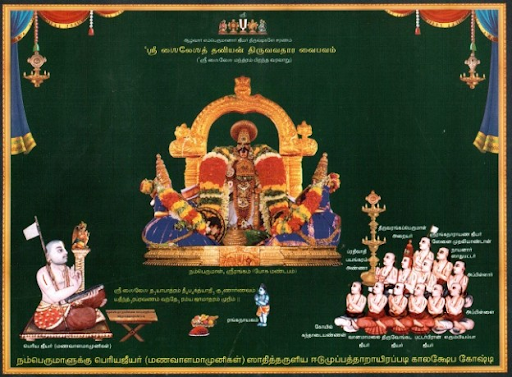thiruvAimozhi has 5 different vyAkyAnams (commentaries).
- 6000 padi by thirukkurugaippirAn piLLAn
- 9000 padi by nanjIyar
- 24000 padi by periyavAchchAn piLLai
- Idu (eedu) 36000 padi of nampiLLai documented by vadakku thiruvIdhip piLLai
- 12000 padi (word-by-word meaning) by vAdhi kEsari azhagiya maNavALa jIyar
padi is a type of measurement – usually one padi means 32 aksharams (letters).
There are also several arumpadha viLakkams (detailed analysis of vyAkyAnams) which
Of these nampiLLai‘s Idu mahA vyAkyAnam is the most comprehensive and detailed vyAkyAnam for thiruvAimozhi. nampiLLai being an expert in both samskrutham and thamizh literature, presents the views of our pUrvAchAryas in relation to sruthi, smruthi, ithihAsams/purANams, etc., in the most relishable and authoritative way.
Out of bhagavAn’s divine will, nampiLLai instructs Idu mahA vyAkyAnam to be kept confidential and highlights that in the future, emperumAn himself will reveal the same to everyone through the most apt AchArya. The history of Idu being transmitted from nampiLLai to mAmunigaL can be viewed at http://guruparamparai.wordpress.com/2013/04/21/eeynni-madhava-perumal/.
Mamunigal learns the Idu mahA vyAkyAnam (and all other vyAkyAnams) through thiruvAimozhi piLLai and becomes fully attached to them. Though he was a great scholar in ubhaya vEdhAntham (samskrutham and thamizh vEdhAntham) – he fully spent his energy in rejuvenating dhivya prabandham and the various vyAkyAnams. He becomes such an expert in Idu mahA vyAkyAnam that he was famously known as “eettup perukkar” (the one who explains the divine meanings of Idu vyAkyAnam in the most detailed and precise manner). SrI ranganAthan, desirous of hearing the Idu vyAkyAnam through mAmunigaL, orders mAmunigaL to lecture the divine meanings of thiruvAimozhi with its vyAkyAnams for a whole year, right in front of his main sanctum in periya kOyil (SrIrangam). mAmunigaL accepts the orders of emperumAn and delivers his lectures with great enthusiasm. He lectures the Idu vyAkyAnam mainly and explains the principles in relation to sruthi, smruthi, ithihAsams/purANams, pAnchArAthram, other vyAkyAnams of thiruvAimozhi and other dhivya prabhandhams etc. On the most auspicious Ani thirumUlam day, he performs sARRumuRai (completion) of his kAlakshEpam. periya perumAL himself appears as a small boy and submits “SrISailESa dhayApAthram” thaniyan (a verse of glorification) to mAmunigaL and accepts him as his own AchArya. From then onwards, the glories of bhagavath vishaya (Idu) kAlakshEpam become well established and the same have been carried out by our sath sampradhAya AchAryas regularly.
Thus, we have seen the glories of thiruvAimozhi, Idu mahA vyAkyAnam and mAmunigaL. emperumAn has great love for all 3 of them and thus he himself heard the thiruvAimozhi vyAkyAnam through mAmunigaL in periya kOyil (SrIrangam).
It is also common practice to explain thiruppallANdu and kaNNinuN chiRuth thAmbu vyAkyAnams before explaining thiruvAimozhi.
- mAmunigaL highlights in upadhEsa raththina mAlai that “vEdhaththukku Om ennumathu pOl” – just like praNavam (OmkAra) is the essence of vEdham and is thus recited at the beginning of any vEdha pArAyaNam, thiruppallANdu highlights the identity of jIvAthmA and paramAthmA. So, thriuppallANdu is explained first to understand the sambandha gyAnam (knowledge about the relationship between jIvAthmA and paramAthmA).
- mAmunigaL highlights in upadhEsa raththina mAlai that “vAyththa thirumanthiraththin maththimamAm padham pOl” – just like the “nama:” which explains the upAyam and is in the middle of thirumanthram, kaNNinuN chiRuth thAmbu explains the upAya gyAnam (knowledge about the means to reach emperumAn) and is explained next.
- nArAyaNAya sabdham in thirumanthram explains the auspicious qualities of bhagavAn and kainkaryam. thiruvAimozhi is filled with narration of bhagavAn‘s auspicious qualities – every paththu (centum) is focussed on a particular quality of emperumAn, every padhigam (decad) is focussed on a particular quality of emperumAn and even every pAsuram is focussed on a particular quality of emperumAn. So, thiruvAimozhi explains the upEya gyAnam (knowledge about the ultimate goal – performing eternal kainkaryam after being overwhelmed with the auspicious qualities of bhagavAn). Thus thiruvAimozhi is explained in the end.
Thus, one needs to study thiruppallANdu, kaNNinuN chiRuth thAmbu and thiruvAimozhi to get a full understanding of the important principles of our sath sampradhAyam.
vyAkyAnam for thaniyans has been provided by piLLai lOkam jIyar.
Many recent-time vidhwAns such as kAnchIpuram SrI u. vE prathivAdhi bhayankaram aNNangarAchAryar swamy have given wonderful and simple explanations for thiruvAimozhi pAsurams based on pUrvAchAryas‘ vyAkyAnams. SrImAn purushOththama nAidu swamy has also given very simple/elegant thamizh translation for eedu vyAkyAnam. With the help of all of these and the mercy of emperumAn, AzhwArs, AchAryas and asmadhAchAryan, we will see the English translation for this wonderful dhivya prabandham. In our translation, we will see the word-by-word meaning from vAdhi kEsari azhagiya maNavALa jIyar‘s 12000 padi commentary and highlights from other vyAkyAnams wherever applicable/possible.
- கோயில் திருவாய்மொழி – எளிய விளக்கவுரை
- कोयिल तिरुवाईमोळी – सरल व्याख्या
- ಕೋಯಿಲ್ ತಿರುವಾಯ್ಮೊೞಿ – ಸರಳ ವಿವರಣೆ
- కోయిల్ తిరువాయ్మొళి – సరళ వ్యాఖ్యానము
- kOyil thiruvAimozhi – Simple explanation
- Introduction (e-book – http://1drv.ms/1LBCXEZ)
- 1st centum
- 2nd centum
- 3rd centum
- 4th centum
- 5th centum
- 6th centum
- 7th centum
- 8th centum
- 9th centum
- 10th centum
adiyen sarathy ramanuja dasan
archived in http://divyaprabandham.koyil.org
pramEyam (goal) – http://koyil.org
pramANam (scriptures) – http://granthams.koyil.org
pramAthA (preceptors) – http://acharyas.koyil.org
SrIvaishNava education/kids portal – http://pillai.koyil.org

No comments:
Post a Comment